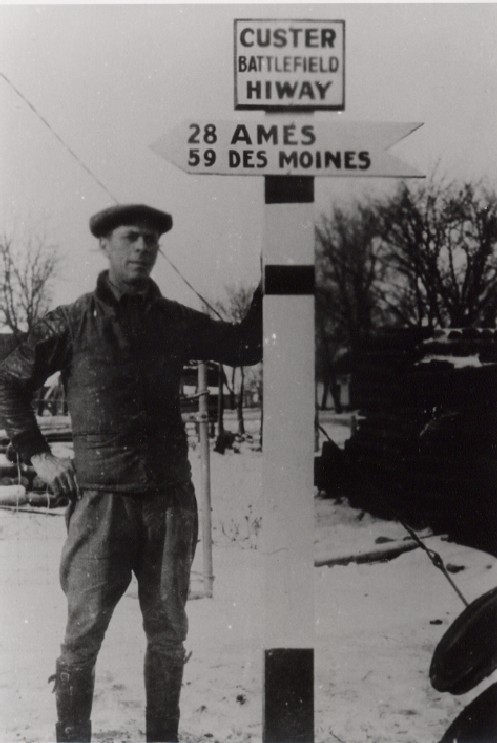When Our Highways Had Names
By Martin E. Nass
Transcribed for the IAGenWeb Project by Janelle Martin, with permission of Martin "Ed" Nass.
In the early settlement of our county and state all of our roads were
dirt, which quickly became mud when they got wet. First, wood planks
were put over the wet spots, and later it was decided to gravel certain
stretches of the roads. The first road in our state was established in
1838 by our Territorial Government, using Federal funds, to expedite the
movement of soldiers. It ran from Dubuque to Keokuk and then to Iowa City.
In 1904, the Iowa Legislature designated Iowa State College as the
highway commission with the mission to develop plans for construction
and maintenance of our roads. In 1913, they established the Highway
Commission. Commission personnel were given the authority to designate
route names and establish the road markings.
Soon, better markings of the main roads became a necessity. In Hamilton County
four main roads were given names by associations that came into
existence to promote these roads. One of the earliest, in 1916, across
Hamilton County was an east-west road that was named Grant Highway for
President Ulysses S. Grant. To identify this route three bands were
painted on corner poles; top and bottom were yellow, and the middle band
was black. This highway covered the longest route. It went from Seaside,
Oregon, to Chicago, Illinois. In our area it passed through Fort Dodge,
Webster City, Blairsburg, and Williams. This path was roughly along what
we now call "old Highway 20."

Another long route was established on December 23, 1919, from Des Moines to
Glacier National Park. It was called the Custer Battlefield Highway.
From Des Moines it passed north to Ames, then turned west and north to
Stanhope and Webster City, and then turned west to Fort Dodge. This
route was marked on telephone poles, fence posts and special poles with
red bands and two white stripes. Between the white stripes was a white
triangle with the black letters C, B, H. In addition, towns erected
arrow markers such as the one shown with this story of a sign in
Stanhope pointing to Ames and Des Moines.
The length of this highway was 1,475 miles. In Hamilton County this road
covered the present US 20 from the west and south on Iowa 17.
A north-south route was established on September 13, 1918, with the name
Wilson Highway for President Woodrow Wilson. It started in Bedford,
Missouri, and ended in Emmons, Minnesota, with a distance across Iowa of
273 miles. The sponsor of this highway was the Wilson Highway
Association. The route was marked on poles with two narrow blue bands
and a wide white band in the center, on which was painted a large red W.
This route was later changed to US 69.
On June 29, 1917, a route of military importance started in Dubuque and
ended in Sioux City, a distance of 360 miles. The sponsor was the
Hawkeye Highway Association. The route was marked on poles at
intersections with a wide white band that had a large blue letter H in
the center. Again, this highway followed approximately the route of US 20.
By 1925, it was decided to number the Iowa roads instead of naming them.
In this same year the U. S. Congress approved the road numbering plan
which assigned odd numbers to north-south roads and even numbers to the
east-west roads. Along the way, the Hawkeye Highway name was changed to
the number Iowa 5, which was changed to US 20 in 1926.
In 1968, the first segment of the freeway was finished between US 69 and
I-35. The maps of the day identified this segment of the freeway as
I-520. This road was extended to Iowa 17 in 1976. By this time it was
decided that this route would have at-grade-crossings, so it could not
be continued as part of the Interstate system. The designation was
changed to US 20. This left our old segment without a number, so it was
assigned as Iowa 928. I have never seen a road sign with that number and
the locals call it "Old 20." A new association named "US 20 Corridor
Association" is pushing for the completion of the 4-lane freeway from
Fort Dodge to Sioux City. On August 22, 2003, a major link from US 65 to
the Waterloo area was finished with the opening of a new bridge over the
Iowa River. Future plans call for US 20 to be completed across the state
after 2007.
|